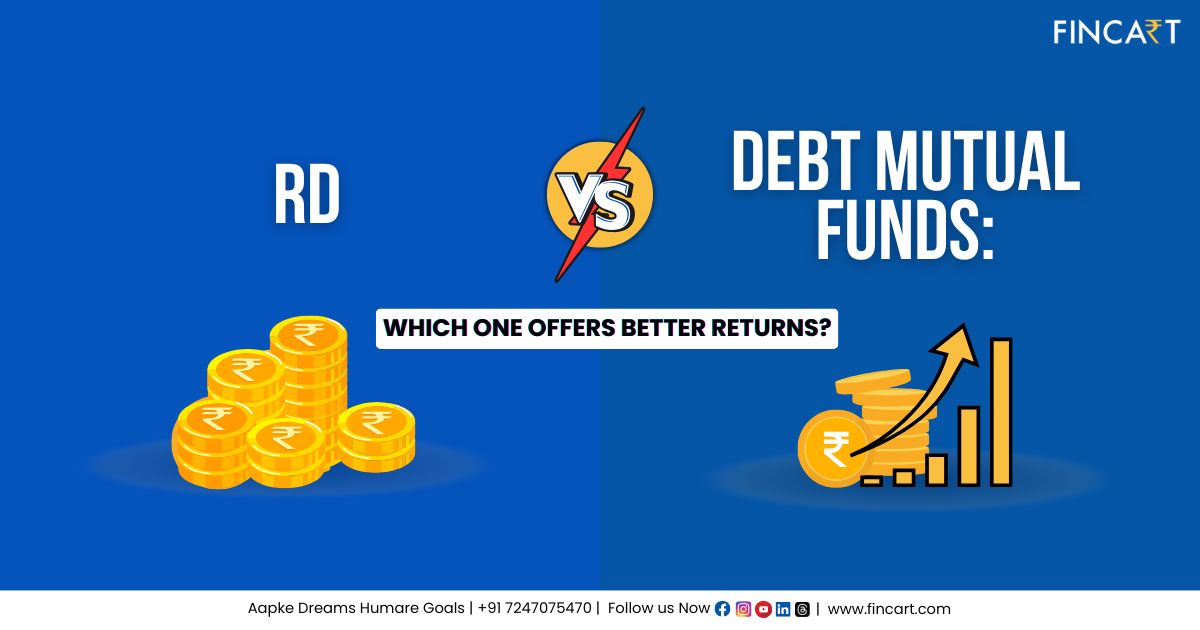In a conversation about low-risk and steady investments, two popular names that almost always come up are recurring deposits and debt mutual funds. Both options are seen as safe places to park your money without worrying about the ups and downs of the share market. So which one’s better for you? Let’s break down the returns, risk, taxation, and liquidity of both options.
Understanding Debt Fund
Debt mutual funds are a type of mutual fund that mainly invests in fixed-income instruments like government and corporate bonds, treasury bills, commercial papers, certificates of deposits, and other money market instruments. The primary goal of these funds is to generate stable returns with lower risk compared to equity funds, which is why they appeal to conservative individuals investing for the short- to mid-term. Examples of debt funds include liquid and gilt funds.
How Do Debt Funds Work?
Debt funds pool money from a large number of investors and invest it in a basket of fixed-income instruments like government bonds, corporate bonds, t-bills, and other short-, mid-, or long-term debt securities. These instruments are basically loans the government or companies take, and in return, they pay interest.
Your returns are the interest these entities pay on these loans. Since these funds are linked to the market, their returns are not fixed or guaranteed and are heavily influenced by interest rate movements. For example, when rates go down, the value of existing bonds goes up and vice versa.
A professional fund manager handles all the investment decisions in a fund. They choose which securities to buy, for how long, and when to switch. The value of your investment is reflected in the NAV (Net Asset Value), which fluctuates a bit daily based on market interest rates and the performance of the underlying securities in the portfolio.
As these securities are essentially loans, they are influenced by changing interest rates and the credibility of the entity taking the loan. For example, a gilt fund is considered one of the safest types of debt funds because it invests only in government securities. As it’s government borrowing, the risk of default is practically zero. But still, even gilt funds are not totally risk-free as they can be sensitive to changes in interest rates.
Apart from diversification and professional management, debt funds offer advantages like liquidity and convenience. You can redeem your investment partially or fully whenever you need (may be subject to a small, short-term exit load). That’s a big plus compared to other low-risk instruments like recurring and fixed deposits, which have lock-in periods and penalties for early withdrawal.
Plus, you can invest with a lump sum or through a Systematic Investment Plan. With SIPs, you can invest small amounts regularly without committing to a fixed amount or tenure. You get the flexibility to change the amount and frequency, pause, or redeem your SIP according to your needs.
Tax on Debt Funds
Dividend income from IDCW option funds is added to your total income and taxed according to your slab rate. Additionally, if this income exceeds Rs. 5,000 in a year, your fund house will deduct a 10% TDS before crediting it into your account.
Capital gains, on the other hand, are profits made upon selling or redeeming your units. Earlier, capital gains tax depended on how long the investment was held. However, this changed in April 2023. Now, all debt fund investments are taxed as per the investor’s tax slab. If you bought debt funds before 1 April 2023, your capital gains will receive a different tax treatment. Consider consulting with a trusted tax consultant who can ensure full compliance with the latest rules and make personalized strategies to help you save as much tax as possible.
Now before we head into debt mutual fund vs recurring deposit, let’s first understand what RDs are and how they work.
Understanding Recurring Deposit
A recurring deposit is a fixed-income investment vehicle offered by banks (as well as post offices). It allows you to deposit a certain amount every month for a specific period on which you earn a fixed interest. When the investment matures, you receive the principal along with accrued interest.
This is one of the critical areas where debt mutual funds vs RD differ. In RDs, you earn a fixed interest but are locked in for the tenure you choose, whereas in debt funds, the returns depend on the prevailing market conditions but the liquidity on offer is high.
How Do Recurring Deposits Work?
The way RDs work is pretty straightforward:
- You choose a regular deposit amount which remains fixed for the entire tenure.
- You select the tenure which can range from short to long term, for example, 6 months to 10 years.
- You earn fixed interest which is decided at the time of opening the RD.
- When your investment matures, you receive the total principal plus interest.
When you invest in a fixed deposit, you are required to deposit a lump sum amount for a fixed tenure of say 1, 3, or 5 years at a predetermined interest rate. With an RD, however, you make regular (mostly monthly) contributions for the predetermined period, making them a good option for those looking to build a disciplined saving habit and earn a fixed interest.
For example, many individuals use RDs as part of their family financial planning to save for children’s education, weddings, or to build emergency funds.
RD interest rates for individuals aged 60 or over are higher compared to non-senior citizens, which makes them an attractive option for those seeking a safe income in retirement.
Tax on Recurring Deposits
Interest earned from RD investments is added to your total income and taxed according to your slab rate. Unfortunately, RDs do not enjoy any tax benefits like normal savings accounts do under Section 80TTA.
Banks and post offices are also required to deduct TDS at 10% if the interest earned on RDs exceeds the following thresholds:
- Rs. 40,000 per financial year for regular individuals.
- Rs. 50,000 per financial year for senior citizens.
In case the investors haven’t provided their PAN, TDS is deducted at a higher rate of 20%.
If your total income falls below the basic exemption limit, you can submit Form 15G (for individuals below 60 years) or Form 15H (for senior citizens) to your bank and they will not make any TDS deductions.
RD vs. Debt Funds: A Tabular Comparison
Here’s a summary of the differences between RD vs mutual fund (debt) investments:
| Factor | Recurring Deposits | Debt Mutual Funds |
| Returns | RDs offer fixed returns but they are generally lower compared to debt funds. | Returns are market-linked and thus vary. They offer the potential for higher returns than RDs. |
| Risk | As they are not market-linked vehicles and offer a fixed interest, RDs are considered very safe investments. | Even though they are very low-risk vehicles, debt fund returns are subject to changes in market conditions. They are particularly exposed to interest rate and credit risks, however, fund managers minimize them through diversification and investing in highly-rated entities. |
| Tenure and Liquidity | RDs have fixed tenures which can range from short (like 6 months) to long (10 years) terms. They offer limited liquidity as early withdrawals can be penalised. | Debt funds don’t tend to have fixed tenures. Some funds may charge a small exit load for premature withdrawals, but the lock-in period is usually minimal, if any. Hence, these investments offer very high liquidity. |
| Flexibility | RDs do not offer much flexibility and investors must stick to the fixed deposit amount and tenure chosen at the time of opening the account. | SIPs are highly flexible as investors can pause or modify the installment amount and frequency of investment. |
| Diversification | No diversification benefits. | Debt funds have highly diversified portfolios managed by professional fund managers. |
| Tax | Interest is added to the investor’s income and taxed accordingly. A 10% TDS is deducted by the bank in case the total interest per financial year exceeds Rs. 40,000 for regular individuals, and Rs. 50,000 for senior citizens. | After 2023, capital gains and dividends from debt funds are also taxed as per the investor’s applicable tax slab. A 10% TDS is deducted by fund houses if the total dividend income earned in a year exceeds Rs. 5,000. |
Consider consulting with our qualified personal investment advisor to understand all you need to know about mutual fund investing. Our personalized approach can help you grow your wealth, save more on taxes, and realise your financial dreams faster.
Risks of Investing in Debt Funds
Even though debt funds are quite safe, they do not guarantee returns like RDs. Some forces like interest rate fluctuations and credit risk can affect their performance.
1. Interest Rate Risk
The prevailing interest rate determines the value of the securities held by a debt fund. When interest rates rise, the value of existing securities falls. This is because the new securities which are issued at higher rates make the older ones not as attractive. When this happens the NAV dips and the returns are impacted.
When interest rates fall, existing securities with higher interest rates become more valuable, and the NAV increases. This risk is mitigated by the fund manager’s decisions and diversification across different maturities and issuers. Debt funds like low-duration or liquid funds are less sensitive to interest rate changes as they invest in securities with very low maturities.
2. Credit Risk
Since AMCs are essentially loaning out investors’ money by investing in bonds and debt instruments issued by companies or the government, there’s always a small chance that the issuer may default on interest payments or repayment of the principal. This is known as credit or default risk. This can also be mitigated by diversification as the chance of many issuers defaulting is quite low. Managers also invest in instruments with high credit ratings to minimise the chances of default. Debt funds like gilt funds are considered the safest in terms of credit risk because they invest in government securities, thus carrying virtually no default risk.
Risks of Investing in a Recurring Deposit
As far as ‘risks’ go, RDs are pretty safe as they are offered by banks under the regulation of the RBI. The interest they offer is fixed and is not affected by changing interest rates. That said, RDs are not without limitations. The interest they offer is not as high as the potential returns of debt funds. In the long run, they might not even be enough to beat inflation. So you may preserve the present value of your money but a long-term investment in an RD may not actually help you grow your wealth meaningfully.
Also, if you miss your regular deposits the bank can impose penalties which will reduce the value of your investment. You can make premature withdrawals, but again, you’ll face penalties. So while RDs offer modest and predictable returns, they do so at the cost of flexibility, growth potential, and inflation-adjusted returns. Seek guidance from a certified financial advisor planner to understand how RDs can fit into your overall financial goals.
Why Choose Debt Funds?
If you’re looking for low-risk investment options, there are many reasons why a wealth advisor may recommend you go for debt funds over recurring deposits:
1. Better returns
Debt funds offer investors the potential for generating higher returns compared to RDs.
2. Professional management
Experienced fund managers handle these funds and employ strategies that balance returns with interest rate and credit risks.
3. Diversification
Just like any other mutual fund, your money gets invested in a basket of securities which also lowers risk.
4. Higher liquidity
Most debt funds have no exit loads or lock-in periods, so you can easily redeem your units whenever needed. Even when there are exit loads they are small and apply only if you redeem your units within a very short time frame (usually within a few days or weeks).
5. SIP
While you can invest a large lump sum in debt funds, it’s not your only option. You can make periodic installments and grow your wealth.
6. Variety
There are many types of debt funds available in the market. You can choose the ones that closely align with your financial goals, investment period, and risk tolerance.
7. Flexibility
If you invest through an SIP, you can easily alter the contribution amount and frequency of investment. Most AMCs even allow you to temporarily pause your SIPs.
Why Choose RDs?
Here are some reasons why investors choose to invest in RDs:
- They offer a fixed interest rate and this predictability attracts conservative investors.
- Their returns are not affected by market conditions.
- Ultra-conservative investors with the goal of preserving their wealth often choose fixed-interest instruments as there’s no risk of capital loss.
Conclusion
Recurring deposits and debt funds are both options for conservative investors. Offered by banks and post offices, RDs give lower but fixed interests. Meanwhile, debt funds are offered by AMCs and their potentially higher returns depend on prevailing market conditions. The main difference between debt mutual funds vs RD stems from their risk and flexibility.
RDs offer guaranteed returns with minimal risk and debt funds come with slightly higher risk but offer the potential for better returns, more liquidity, and investment flexibility. The choice between the two depends on your financial goals and risk appetite, but you can go for both and diversify your portfolio.
Frequently Asked Questions
1. Which is better, RD or mutual fund?
The choice between a debt mutual fund vs recurring deposit depends on your goals, risk tolerance, and liquidity preference. Debt funds carry some degree of risk as they are market-linked vehicles but they make up for it by offering flexibility, higher returns and allowing you to exit any time you need. On the other hand, RDs offer lower but fixed returns and require you to commit to the entire tenure of the investment.
2. What is the difference between RD and SIP in debt funds?
With an RD, you make fixed contributions for a predetermined period and earn a fixed interest. An SIP in a debt fund offers market-linked returns and is more flexible as you can increase, decrease, or pause it when you need. It’s also much easier to liquidate a debt fund SIP as the maturity is not fixed. You can redeem your investment anytime (in some cases subject to short exit loads).
3. What are the disadvantages of RD?
Apart from the lower returns and flexibility they offer, the biggest disadvantage of investing in an RD vs mutual fund investments is their limited liquidity. Even though you may be able to make premature withdrawals, they often come with penalties and reduced interest rates. Moreover, you may be required to complete a minimum lock-in period before you’re allowed to make any withdrawal at all.
4. Is a debt mutual fund good?
Yes! An investment in debt mutual funds can be good for conservative investors looking for stable returns, built-in diversification, and professional management. You can easily invest in them with either a lump sum or through an SIP and enjoy higher, market-linked returns by investing in debt mutual funds vs RD. Though they carry a slight degree of risk, they offer high liquidity, convenience, and flexibility.
5. How do I avoid tax on RD?
You cannot avoid paying tax on RD if your annual income exceeds the basic exemption limit. The interest earned from this investment is added to your income and taxed according to your income tax slab rate and is also subject to 10% TDS if your total annual interest crosses a certain threshold.




